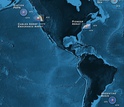News Release 16-062
World Oceans Day: Bring the seas into your home; exploration is one click away
National Science Foundation Ocean Observatories Initiative links oceans, shore

View video
Watch a video showing Axial Seamount in the Pacific Ocean, via the Ocean Observatories Initiative.
June 6, 2016
This material is available primarily for archival purposes. Telephone numbers or other contact information may be out of date; please see current contact information at media contacts.
In the years after the HMS Challenger set sail from Portsmouth, England, in 1872, researchers made discoveries that laid the foundation of the science of oceanography. These scientists couldn't have imagined that more than a century later, almost anyone can discover secrets of the sea -- even if he or she lives thousands of miles from a coastline.
On World Oceans Day, June 8th -- or anytime -- the Ocean Observatories Initiative (OOI), funded by the National Science Foundation (NSF), is making the seas accessible 24 hours a day, seven days a week to anyone with an Internet connection.
"The OOI is placing as much ocean data online as possible and making it available in real time," says Roger Wakimoto, NSF assistant director for Geosciences. "In addition to scientific discovery, we hope to spark the public's interest in the sea, and contribute to the safety of those who make their living on the water or vacation along the coast."
Permanent scientific presence
The OOI is a permanent scientific presence in the oceans. It consists of 83 platforms with more than 830 instruments, providing some 100,000 scientific and engineering data products. The platforms and instruments are spread across seven arrays located in the Atlantic and Pacific Oceans.
The OOI Data Portal has opened its doors to allow users -- scientists, educators and the public -- to freely access OOI data. Over recent months, the quantity of information and the tools for downloading and plotting it have steadily increased, and OOI continues to expand its data availability.
"Much like the HMS Challenger crew, OOI is employing new technology that we hope will revolutionize our understanding of the oceans," says Greg Ulses, OOI director at the Consortium for Ocean Leadership, which manages the OOI Program for NSF. "We're doing that by focusing on our online data delivery. We live in a time of constant Internet connection -- your computer, your tablet, your phone -- so we're giving people access to the oceans by meeting them where they are: online."
Data from OOI will foster scientific advancements by helping researchers gain a better understanding of earthquakes and shifts in tectonic plates; species that live at hydrothermal vents and methane seeps; climate and weather phenomena such as El Nino; ocean acidification; the upwelling that fuels productive coastal fisheries; and the links between ocean circulation and climate.
Benefits to public
Scientists aren’t the only ones benefitting from OOI. A suite of online tools, including data visualization exercises and lesson plans, allows educators to engage students in scientific inquiry on oceanographic concepts. In addition, commercial or recreational fishers may monitor offshore conditions by checking data from nearby buoys.
Anyone with an Internet connection can download and view plots of OOI data from all arrays or watch a live-streaming, high-definition video from a hydrothermal vent 250 miles off the coast of Oregon.
Tales of krakens, whirlpools, and passages to foreign lands have long united people and kindled interest in the sea's mysterious forces. This year on World Oceans Day and beyond, celebrate by connecting with the ocean live -- without even getting wet.
More about OOI
OOI's network of platforms and sensors tracks the oceans' physical, chemical, geologic and biological properties from the seafloor to the sea surface. Using undersea robotics, moorings, fiber-optic cables, and specialized instrumentation, OOI links technology and advanced engineering capabilities to an intricate cyberinfrastructure, bringing ocean observing data to shore.
OOI is an NSF cooperative agreement with the Consortium for Ocean Leadership, which has overseen OOI construction and initial operations through partnerships with the University of Washington, Oregon State University, Rutgers University and the Woods Hole Oceanographic Institution.
-NSF-
-
The OOI's seven arrays are deployed in key locations in the Atlantic and Pacific Oceans.
Credit and Larger Version -
The NSF OOI cabled shallow profiler mooring science pod hovers above its docking station.
Credit and Larger Version -
OOI cabled array instruments are affixed to El Gordo hydrothermal vent in the Pacific Ocean.
Credit and Larger Version -
Off Washington, the coastal endurance inshore surface mooring collects Pacific Ocean data.
Credit and Larger Version -
A coastal glider floats along the ocean surface, soon to sample water.
Credit and Larger Version -
A surface buoy bobs in waves at the OOI Global Argentine Basin site in the Southern Hemisphere.
Credit and Larger Version
Media Contacts
Cheryl Dybas, NSF, (703) 292-7734, email: cdybas@nsf.gov
Leslie Smith, Consortium for Ocean Leadership, (202) 787-1613, email: lsmith@oceanleadership.org
Related Websites
NSF Ocean Observatories Initiative: http://oceanobservatories.org/
The U.S. National Science Foundation propels the nation forward by advancing fundamental research in all fields of science and engineering. NSF supports research and people by providing facilities, instruments and funding to support their ingenuity and sustain the U.S. as a global leader in research and innovation. With a fiscal year 2023 budget of $9.5 billion, NSF funds reach all 50 states through grants to nearly 2,000 colleges, universities and institutions. Each year, NSF receives more than 40,000 competitive proposals and makes about 11,000 new awards. Those awards include support for cooperative research with industry, Arctic and Antarctic research and operations, and U.S. participation in international scientific efforts.
Connect with us online
NSF website: nsf.gov
NSF News: nsf.gov/news
For News Media: nsf.gov/news/newsroom
Statistics: nsf.gov/statistics/
Awards database: nsf.gov/awardsearch/
Follow us on social
Twitter: twitter.com/NSF
Facebook: facebook.com/US.NSF
Instagram: instagram.com/nsfgov








